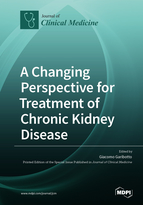A Changing Perspective for Treatment of Chronic Kidney Disease
A special issue of Journal of Clinical Medicine (ISSN 2077-0383). This special issue belongs to the section "Nephrology & Urology".
Deadline for manuscript submissions: closed (31 March 2021) | Viewed by 43226
Special Issue Editor
2. IRCCS Ospedale Policlinico San Martino, Genoa, Italy
Interests: chronic kidney disease; nutrition; diabetic nephropathy; inflammation; oxidative stress; amino acid and protein metabolism
Special Issues, Collections and Topics in MDPI journals
Special Issue Information
Dear Colleagues,
Chronic kidney disease (CKD) has become an enormous worldwide health problem, both in developed and less developed countries. The incidence and prevalence of CKD is high, and is associated with increased mortality and morbidity. Of note, CKD is the 12th most common primary cause of death, accounting for about 1 million deaths per year worldwide. CKD and end-stage renal disease are characterized by the progressive development of a series of complications, such as anemia, hyperkalemia, hypervolemia, mineral and bone disorders (CKD-MBD), metabolic acidosis, hyperuricemia and wasting; all of these complications have been shown to be associated with adverse outcomes, and can contribute either individually or in association to the cardiovascular morbidity and mortality observed in CKD. While at this time CKD progression is not treated with high efficacy, new biomarkers of kidney fibrosis have become available in recent years and new treatments for kidney fibrosis and cell loss could become soon available. In addition recent progress in our understanding of CKD pathophysiology together with the development of novel therapeutic agents has led to a renewed attention on the treatment of CKD–associated metabolic complications which are now are amenable to therapeutic interventions. All these important issues are addressed in this volume.
Issues:
New options for anemia in CKD
New options for treatment of hyperkalemia
New targets for treatment of metabolic acidosis
Can we target oxidative stress in CKD?
Native vitamin D: is so important?
A CKD-MBD perspective in 2020
A new paradigm: treating hyperuricemia
Kidney fibrosis: new biomarkers and treatments
How should we evaluate CKD progression?
Prevention of acute kidney injury in an aging population
Prevention of cardiovascular mortality in CKD: a 2020 perspective
Nutrition in CKD: a 2020 perspective
Prof. Giacomo Garibotto
Guest Editor
Manuscript Submission Information
Manuscripts should be submitted online at www.mdpi.com by registering and logging in to this website. Once you are registered, click here to go to the submission form. Manuscripts can be submitted until the deadline. All submissions that pass pre-check are peer-reviewed. Accepted papers will be published continuously in the journal (as soon as accepted) and will be listed together on the special issue website. Research articles, review articles as well as short communications are invited. For planned papers, a title and short abstract (about 100 words) can be sent to the Editorial Office for announcement on this website.
Submitted manuscripts should not have been published previously, nor be under consideration for publication elsewhere (except conference proceedings papers). All manuscripts are thoroughly refereed through a single-blind peer-review process. A guide for authors and other relevant information for submission of manuscripts is available on the Instructions for Authors page. Journal of Clinical Medicine is an international peer-reviewed open access semimonthly journal published by MDPI.
Please visit the Instructions for Authors page before submitting a manuscript. The Article Processing Charge (APC) for publication in this open access journal is 2600 CHF (Swiss Francs). Submitted papers should be well formatted and use good English. Authors may use MDPI's English editing service prior to publication or during author revisions.
Keywords
- chronic kidney disease
- eGFR
- kidney fibrosis
- anemia
- acidosis
- hyperkalemia
- cardiovascular disease
- AKI
- aging







